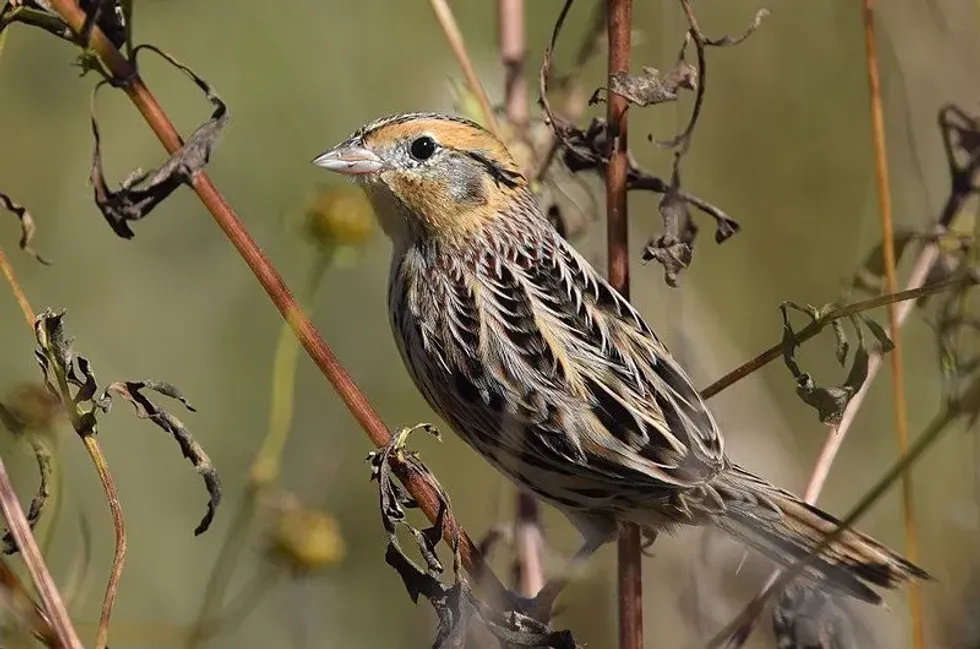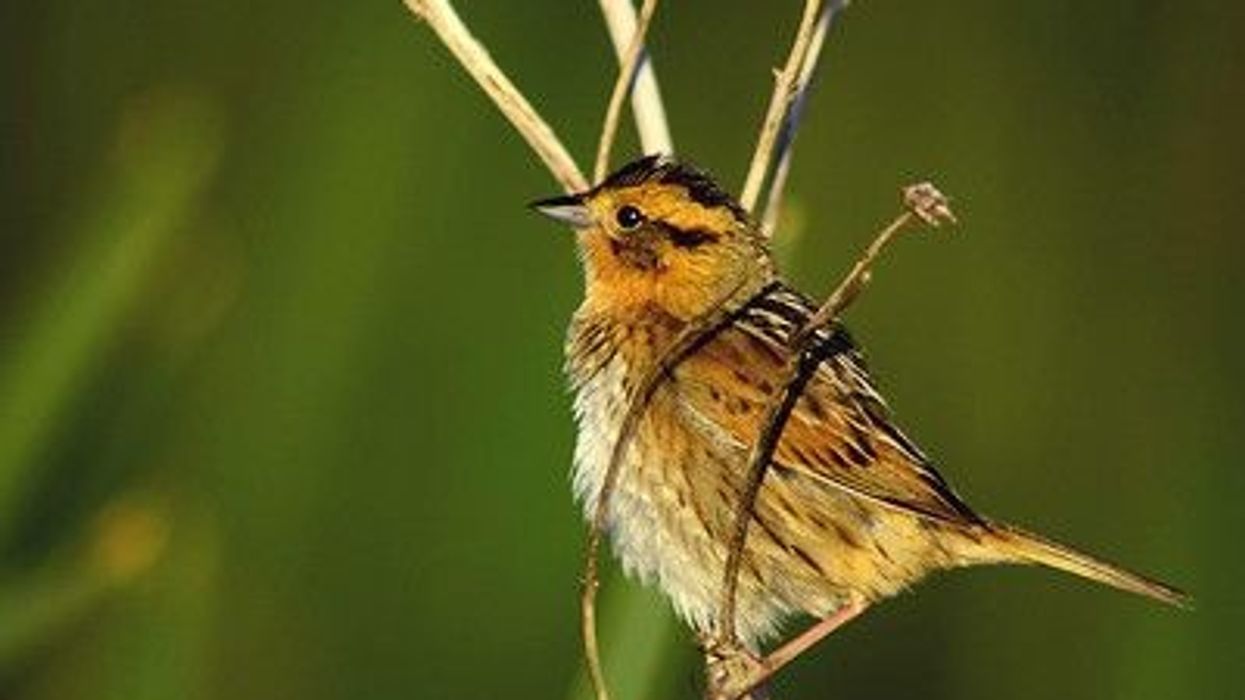LeConte's sparrow, Ammospiza leconteii, belongs to the order Passeriformes family. It is one of the smallest North American sparrow species that live in various parts of the United States, particularly in Canada.
Their flight zone is only 3.3-9.8 ft (1-3 m) as it prefers to run across the ground. LeConte's bird rarely flies over a foot or two above the long grass.
Because of its covert nature, there is less information available about this bird, especially related to breeding, nesting, and juveniles. Their diet includes insects and weeds. These bird species are short-distance migrants and reside within North America during migration.
The face of this sparrow is light yellowish-orange, while their feet and legs are brownish pink, along with orange buff on their upper breast and head. Their body length is about 4.7 in (12 cm).
The name of this bird was spelled or known as Le Conte's sparrow. However, through the American Ornithological Society (AOS), the LeConte's sparrow rename was done, which became the common name of this bird, in the year 2017.
The breeding season is from April to May. The nest site is generally covered in long grasses.
They prefer a habitat in wet meadows and grasslands. Today, they can also be spotted in urban areas, perching on wires and trees. The development of roads and transportations have affected these birds due to their highly sensitive nature towards sound and pollution.
The identification of these birds can be quite difficult since they are rare and have similarities with other sparrow species. Much detailed information about these bird species has been made available in 'The Sibley Guide to Birds', second edition, by Alfred A. Knopf, New York, USA.
If the LeConte bird interests you then keep reading for more information, and you may also want to check out western kingbird and palm warbler.
LeConte's Sparrow Interesting Facts
What type of animal is LeConte's sparrow?
The LeConte bird species are a type of sparrow birds, which belong to the order Passeriformes family.
What class of animal does a LeConte's sparrow belong to?
The LeConte's sparrow, Ammospiza leconteii, is the bird species that belong to the class Aves and order Passeriformes family.
How many LeConte's sparrows are there in the world?
The population size of LeConte's sparrow estimates between three and five million breeding birds around the world.
Where does a LeConte's sparrow live?
The LeConte bird distribution can be seen in specific regions of Canada, including British Columbia, Alberta, Manitoba, Quebec, middle Ontario, and also in some southern areas, such as Minnesota, Michigan, and Montana. It spends its winters in North Carolina and Central Texas, Illinois, and Missouri of the United States.
They prefer a habitat consisting of wet areas and grasslands for their survival and often can be found in cities too.
They migrate rarely to certain places. However, they are uncommon migrants to the Wisconsin region, but the Leconte's sparrow Wisconsin have been found to nest throughout the northern and central portion of the state.
What is LeConte's sparrow's habitat?
The LeConte sparrow likes to live in great plains of grasses with an adequate cover of herbaceous vegetation for shelter. Various important habitats include tall grass, weedy hayfields, damp soil areas, edges of marshes, meadows, crop stubble, coastal prairie, and shallow marshes edges.
Sometimes, it prefers fens and lakeside within the boreal forest.
However, in South Dakota, the sparrow Ammospiza is often seen in the damp soil areas and highland grassland habitats. The type of vegetation greatly impacts the population size or group size of this bird than the other aspects, such as patch size or climate change.
Who do LeConte's Sparrows live with?
LeConte's sparrow birds are mostly seen alone or in pairs. They are usually short-distance or non-migrant bird species.
How long does a LeConte's sparrow live?
The life span of sparrow Ammospiza is approximately 4.1 years.
How do they reproduce?
For the LeConte sparrow species, the season of breeding ranges from April to May. To attract females, the male usually sings from the cover of thick grasses, perched on long grass or in flight.
The clutch size ranges between two to six eggs although, four eggs being the most common. The female LeConte performs most of the incubation, but both parents do feeding duties. The incubation period is for 11-13 days.
The juvenile LeConte's sparrow, Ammospiza leconteii, is pale brown with patches and self-sufficient. One pair breeds about two times a year.
The Ammospiza sparrow is a secretive bird and an arduous bird to see well. Therefore, there is succinct information related to hatching and fledging.
The female LeConte sparrow builds the cup-shaped nest, consisting of grasses and internally lined with soft grass or feathers. The nest is normally adhered to the long-standing grasses or sedges and is few inches above the ground. The eggs are mostly sub-elliptical.
They are white with tones of gray, greenish-blue with brown spots or speckles congregated near the large end of eggs. The breeding range of these birds can be highly seen in North Dakota and South Dakota.
What is their conservation status?
They are still a common species of sparrows in much of their habitats, although they faced some downturns due to habitat loss. LeConte's sparrows survive over a wide range of geographic regions.
The IUCN listed these birds in the Least Concern category. Therefore, no action plan for preservation is ongoing for Leconte's Passeriformes. But considering the decreasing population, conservation reserve programs might help to give big areas of suitable habitat for this species.
LeConte's Sparrow Fun Facts
What do LeConte's sparrows look like?
The identification of the North American LeConte's sparrow species is challenging because they are extremely secretive and coexist with other species of sparrows, such as Nelson's sharp-tailed sparrows with no crown stripe, Baird's sparrows with a buff crown stripe, and the grasshopper sparrow with duller and buffier underparts. Both sexes of Ammospiza leconteii look similar in appearance.
LeConte's sparrows are the smallest sparrow species with a relatively big head, buffy orange face, tiny gray-colored bill with gray ear patch, and diminutive sharp tail. They also possess a dark brown crown with a white middle line stripe.
The neck's nape is mostly lilac gray with streaks of chestnut color, but the upper part has brown and beige streaks. The belly is pale white, whereas the breast and sides have orange-yellow plumage with dark brown streaks.
These birds have brown-pink legs and feet. The males and females have relatively similar sizes.

How cute are they?
Due to the diminutive size and colorful plumage, the LeConte bird looks delightful to the eyes. Additionally, their quick short voice and songs make them look more attractive.
How do they communicate?
The LeConte's Passeriformes communicate through a short squeaky call or song of less than one second, which sounds like 'tzeek-tzzzz tick'. It resembles the call of the grasshopper.
However, it is often confused with the Nelson's sparrow song. During mating season, a male normally sings from a covered place, although it can also be seen singing from the peak of long grass stem, or in flight.
How big is a LeConte's Sparrow?
The length of this birds of North America is about 4.7 in (12 cm), which is 20 times bigger than a bee.
How fast can a LeConte's Sparrow fly?
The LeConte's bird flies rarely. But when it does, it flushes readily.
How much does a LeConte's sparrow weigh?
It weighs between 0.4-0.6 oz (12-16 g).
What are the male and female names of the species?
There are no specific names given to the male and female of these birds species.
What would you call a baby LeConte's sparrow?
The baby or hatchling of these birds does not have a special name. Like most other bird babies, the juvenile LeConte's sparrow is generally known as chicks, offspring, or young ones.
What do they eat?
Most of the time, the LeConte's sparrow species forage on or near the earth's surface, often under thick vegetation. In summer, they feed on insects, such as leafhoppers, moths, weevils, spiders, and caterpillars. However, during winter, the diet includes grass seeds and weeds, for example, yellow foxtail, little bluestem, Indian grass, scorpion grass, and northern dropseed.
Are they poisonous?
No, these bird species are non-poisonous birds of North America.
Would they make a good pet?
The LeConte's sparrow species are secretive birds who like to live on cover. They sing a melodious song and make different chirping sounds, which are pleasant to hear.
As non-dangerous creatures, they would be adorable pets with some specific arrangements according to their behavior and diet. You can also check out detailed information on these birds through field guides made by experts and scientists.
Did you know...
Scientists took hundred years to find, identify, and describe the first LeConte's sparrow nest. During research in Wisconsin, scientists found only eight out of 86 male LeConte's singing on the branches revealed enough to give an identifiable view.
You can see LeConte's sparrow at Cove Island Wildlife Sanctuary.
Who was LeConte's Sparrow named after?
John James Audubon named this sparrow after his pal, Doctor Le Conte.
How to tell the difference between a LeConte's Sparrow and a House Sparrow
The LeConte's sparrow prefers to live in the cover of vegetation, but the common house sparrow lives near the human settlements or open regions.
Here at Kidadl, we have carefully created lots of interesting family-friendly animal facts for everyone to discover! Learn more about some other birds from our robin facts and evening grosbeak facts pages.
You can even occupy yourself at home by coloring in one of our free printable Leconte's sparrow coloring pages.









